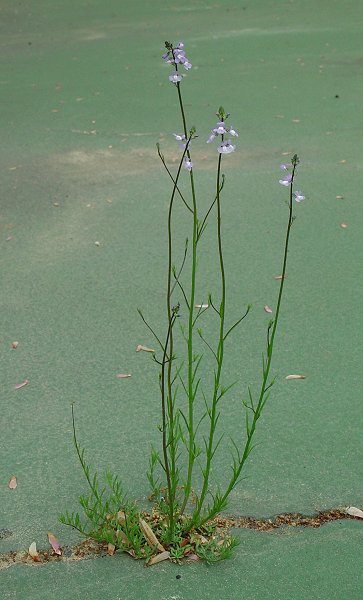Nuttallanthus canadensis (L.) D.A. Sutton
Blue Toadflax

Native
CC = 3
CW = 5
MOC = 25
© DETenaglia
Nuttallanthus canadensis (L.) D.A. SuttonBlue Toadflax | |
 |
Native CC = 3 CW = 5 MOC = 25 |
© DETenaglia |
|
Family - Plantaginaceae Habit - Taprooted annual forb. Vegetative rosettes sometimes present, these 1-6 cm long (sometimes elongating to 10 cm with age), mostly prostrate, sometimes with ascending tips. Stems - Fertile stems erect, to 40 cm, unbranched or with ascending branches toward the tip, glabrous, sometimes sparsely glandular-hairy in the inflorescence.
Leaves - Simple, entire, glabrous, with at most a midvein apparent, of 2 kinds: those of the vegetative stems mostly opposite or in whorls of 3, sessile or occasionally short-petiolate, the blades 0.2-1.0 cm long, linear to oblanceolate or spatulate; those of the fertile stems mostly alternate (except sometimes the lowermost), sessile, 0.5-3.0 cm long, 0.5-2.0 mm wide, linear or threadlike.
Inflorescences - Terminal racemes with the flowers relatively widely spaced, even toward the start of flowering. Bracts 1-7 mm long, linear, bluntly pointed at the tip. Flower stalks 2-5 mm long, strongly ascending.
Flowers - Perfect. Calyces deeply 5-lobed, 2-4 mm long, the lobes linear to narrowly lanceolate, green with a narrow, thin, pale or white border along the margins. Corollas bilabiate, 5-lobed, pale blue, 8-11 mm long (including the spur), the upper lip 1.2-1.6 mm long, the lower lip 2-6 mm long, the tube with a curved, slender basal spur 2-6 mm long. Fertile stamens 4, the filaments of 2 lengths, not exserted, somewhat curved inward toward their tips, the anther sacs spreading; staminodes absent. Style 1, not exserted, the stigma capitate, unlobed.
Fruits - Capsules 2.0-3.5 mm long. Seeds 0.4-0.5 mm long, with low ridges along the angles, the faces with minute tubercles between them, sometimes appearing nearly smooth.
Flowering - May - November Habitat - Glades, bluffs, sand prairies, forest openings, savannas, streambanks, fens, fields, pastures, railroads, and open, disturbed areas; on calcareous and acidic substrates. Origin - Native to the U.S. Lookalikes - N. texanus. Other info. - This slender little plant is found in a handful of scattered Missouri counties, mostly south of the Missouri River. Its range in the continental U.S. is mostly within a wide band along the Gulf and Atlantic Coastal regions, with other scattered occurrences throughout the eastern half of the country. It can be identified in the field by its irregular blue flowers and its small thin leaves. The nectar-filled spur at the base of the flower is about as long as the calyx or only slightly longer. Another species, N. texanus (Scheele) D.A. Sutton, is similar but has larger flowers with basal spurs much longer than the calyx. That species also tends to have more crowded inflorescences, whereas the inflorescence of N. canadensis is usually relatively open and sparse. The two species are sometimes difficult to distinguish and are sometimes found in mixed populations. Photographs taken in Brown Summit, NC., 4-24-03, and off Lee Rd 27, Auburn, AL., 4-17-05 (DETenaglia); also at Holly Ridge Conservation Area, Stoddard County, MO, 4-20-2013, and Sand Prairie Conservation Area, Scott County, MO, 5-6-2020 (SRTurner). |